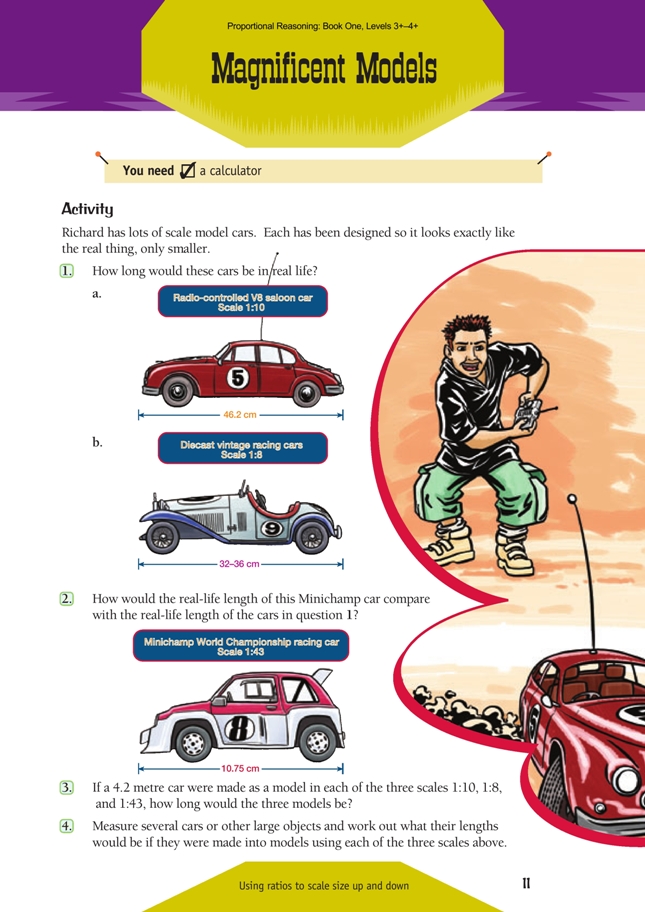This is a level 5 number activity from the Figure It Out series. It relates to Stage 8 of the Number Framework.
A PDF of the student activity is included.
Click on the image to enlarge it. Click again to close. Download PDF (639 KB)
use ratios to scale up and down from drawings
Number Framework Links
Use this activity to:
• encourage the transition from advanced multiplicative strategies (stage 7) to advanced proportional strategies (stage 8)
• develop confidence in students who are beginning to use advanced proportional strategies (stage 8).
A calculator
This activity explores direct proportion in a context involving scale models.
Some of your students may have had experience with scale models. If they have kept any of the boxes that contained their models, ask them to bring them and show the class. They may even be prepared to bring along the models.
Discuss and compare the scales on the boxes. Scales for car models are often 1:18, 1:24, and 1:64. Aeroplane models are often 1:48 or 1:87. Discuss with your students why such a range of scales exists. If you are able to obtain two models of the same object in different scales, you will be able to demonstrate the scaling effect in an interesting way.
Ensure that the students understand that (i) the notation “1:10” means that 1 unit of length on the model represents 10 units on the real-life object, and (ii) the ratio is true for any unit of length.
Question 1a provides a context for exploring strategies for multiplying by 10. The old rule, “to multiply by 10, add a 0”, is shown to be nonsense here: 46.2 becomes 46.20, which is mathematically no different. (Well, let’s not get into limits of accuracy!) Encourage your students to see that when a number is multiplied by 10, the digits move 1 place to the left, and so 46.2 becomes 462.0.
Revise their knowledge of measurement by asking them to express the measurement in centimetres as a measurement in metres. Get them to compare the position of the digits after multiplying the centimetre length by 10 and then dividing the result by 100 to give a measurement in metres: 46.2 cm multiplied by 10 becomes 462.0 cm, which, when divided by 100, becomes 4.62 m. Encourage them to make observations such as “Multiplying by 10 moves the digits one place to
the left of the decimal point, while dividing by 100 moves them two places to the right.”
Question 1b shows a range of model lengths rather than a specific length. Students will need to use the scale to express this range in metres.
When the students compare the Minichamp racing cars in question 2 with the V8 in question 1, they will find that the Minichamp cars are 0.25 cm longer. You could ask your students about whether this amount “matters” in the circumstances. Remind them what a quarter of a centimetre looks like. The Answers suggest that it is sensible to round the measurement to the nearest centimetre.
In question 3, students need to scale down instead of scale up as in the previous two questions. Point out that scale ratios are usually expressed as “1 to something”, not “2 to something”. As long as this is the case, it is a simple matter of multiplying by the larger number in the ratio to scale up, or dividing by the larger number to scale down. The students should be given every chance to deduce this for themselves.
Expect your students to solve the 1:10 and 1:8 scale problems mentally or on paper but to use the calculator option for the 1:43 scale. They should discuss their mental strategies for solving the problems. A possible strategy for the 1:8 problem may go like this: “I thought of 4.2 m as 420 cm. The model is 8 times smaller, so I needed to divide by 8. I split 420 into 400 + 16 + 4 to make it easy. 400 ÷ 8 = 50; 16 ÷ 8 = 2; 4 ÷ 8 = 1/2. So the model is 50 + 2 + 1/2 = 52 1/2 (or 52.5) cm.”
In addition to calculating the lengths asked for in question 4, the students could try drawing outlines of their chosen objects on square grid paper, using one or more of the three scales. They will need to use objects that are no longer than 3 m if they are to fit on A4 paper at a scale of 1:10. And they’ll need to take some vertical measurements too.
As an extension, you could get your students to draw geometrical shapes (or more complex objects) using a suitable computer program and then experiment with the stretch or enlarge function to change their size. If they do this, they will need to express increases or decreases as percentages rather than ratios.
Answers to Activity
1. a. 4.62 m. (10 x 46.2 cm = 462 cm = 4.62 m)
b. Between 2.56 and 2.88 m
2. Measured to the nearest cm, the Minichamp racing car (43 x 10.75 = 462 cm = 4.62 m) and the V8 saloon (4.62 m) are the same length. The vintage racing cars are a lot smaller.
3. 420 x 1/10 = 42 cm (1:10 scale)
420 x 1/8 = 52.5 cm (1:8 scale)
420 x 1/43 = 9.8 cm (1:43 scale)
4. Answers will vary, depending on the cars or other objects chosen.
